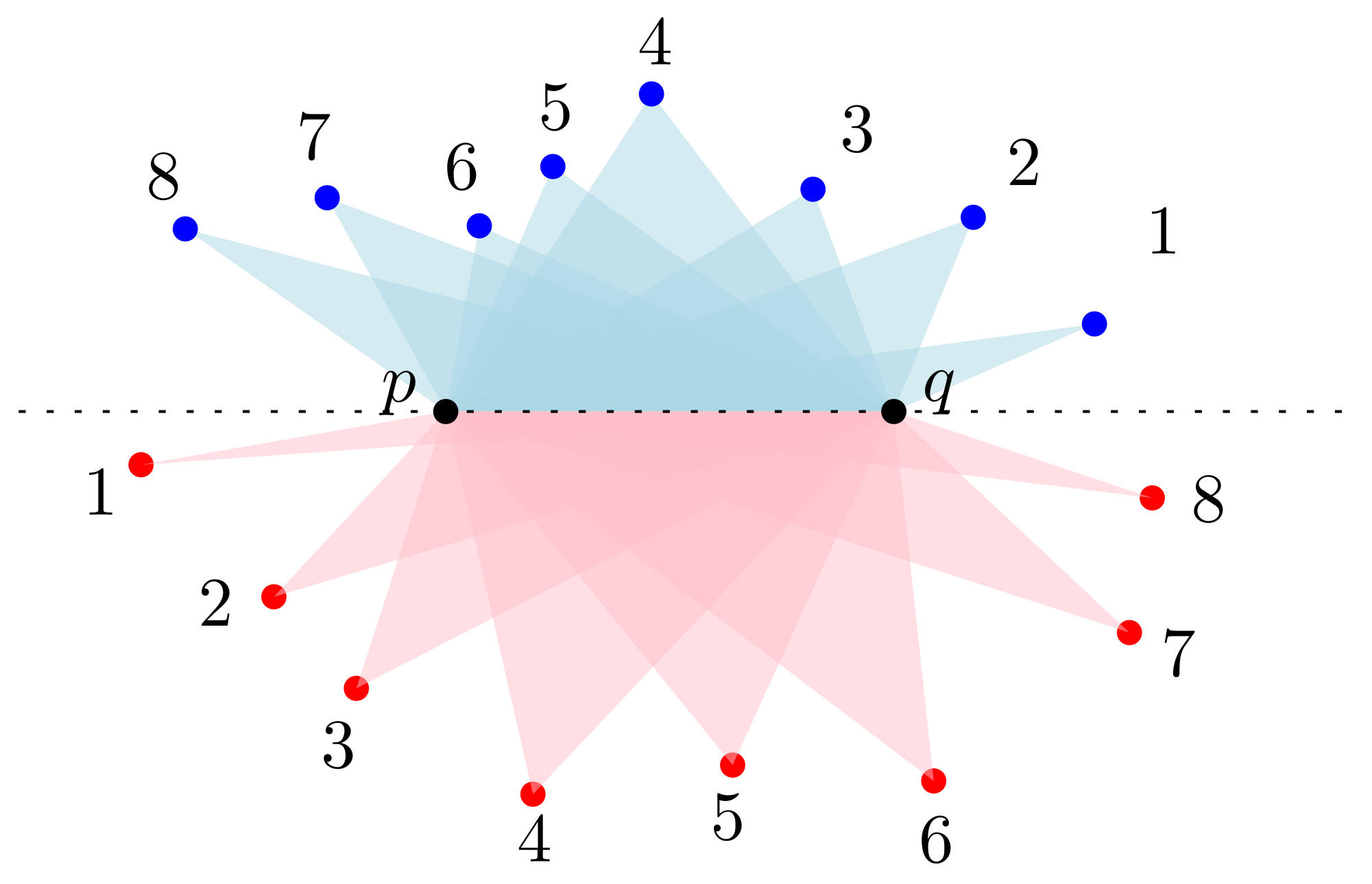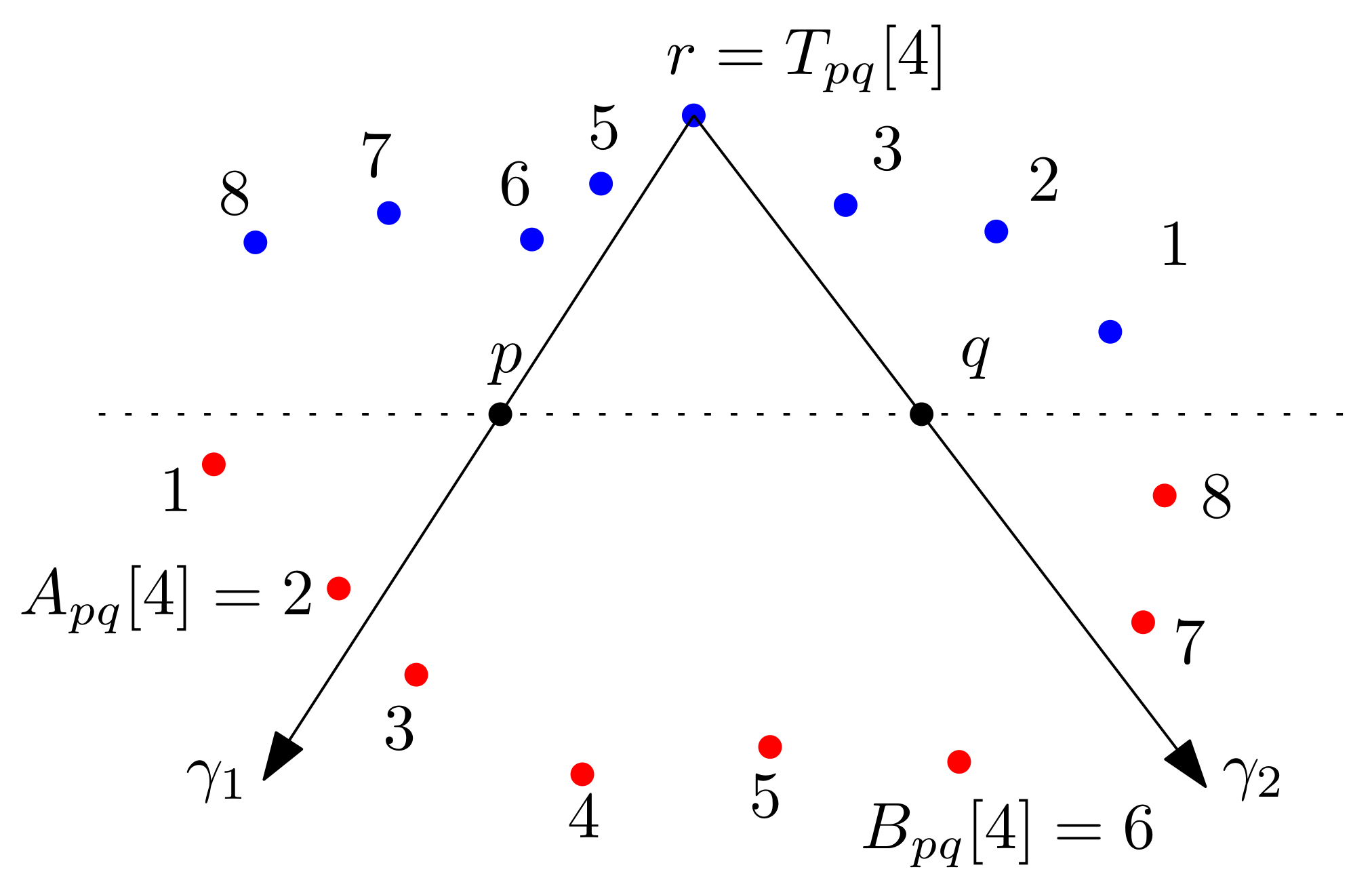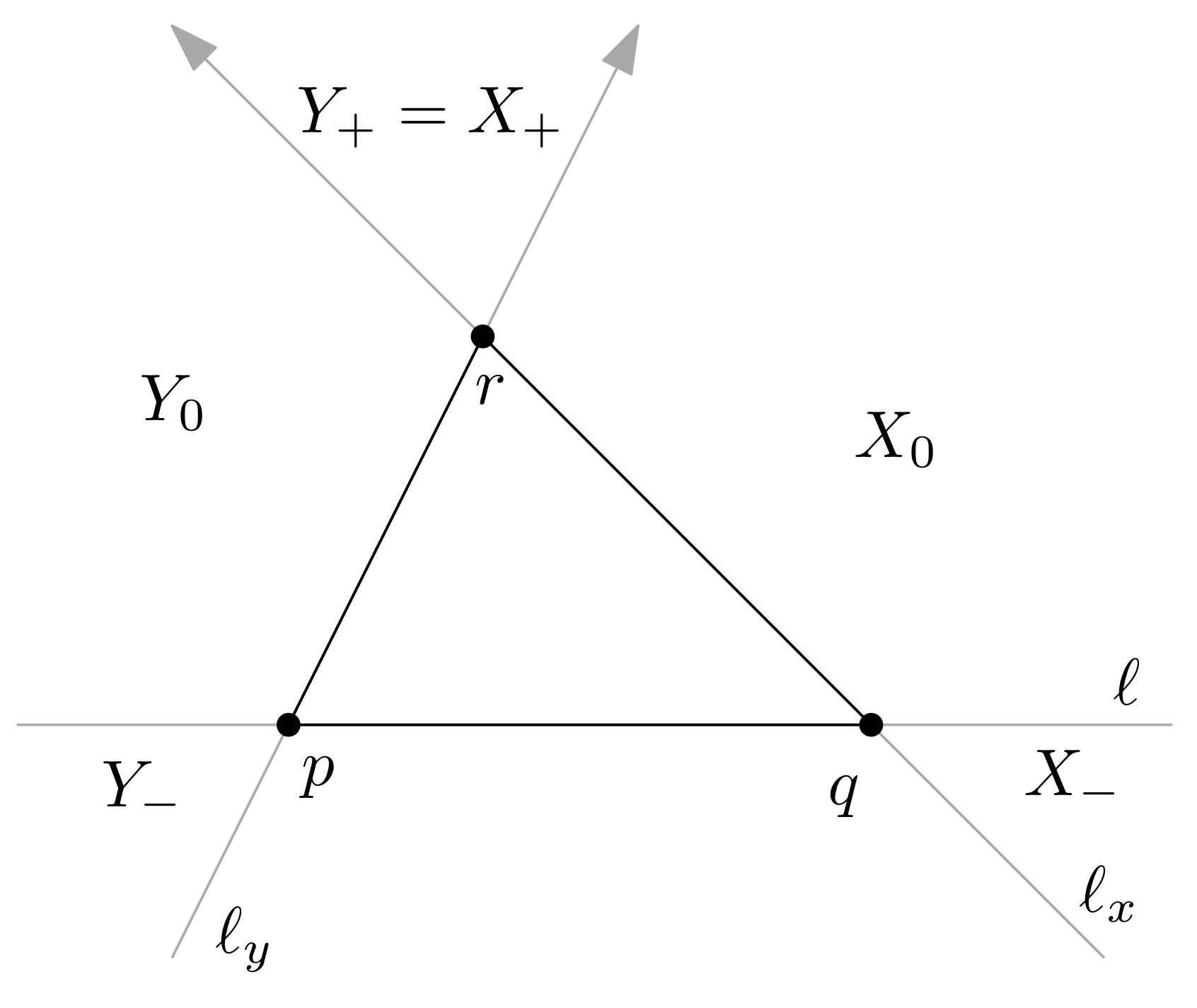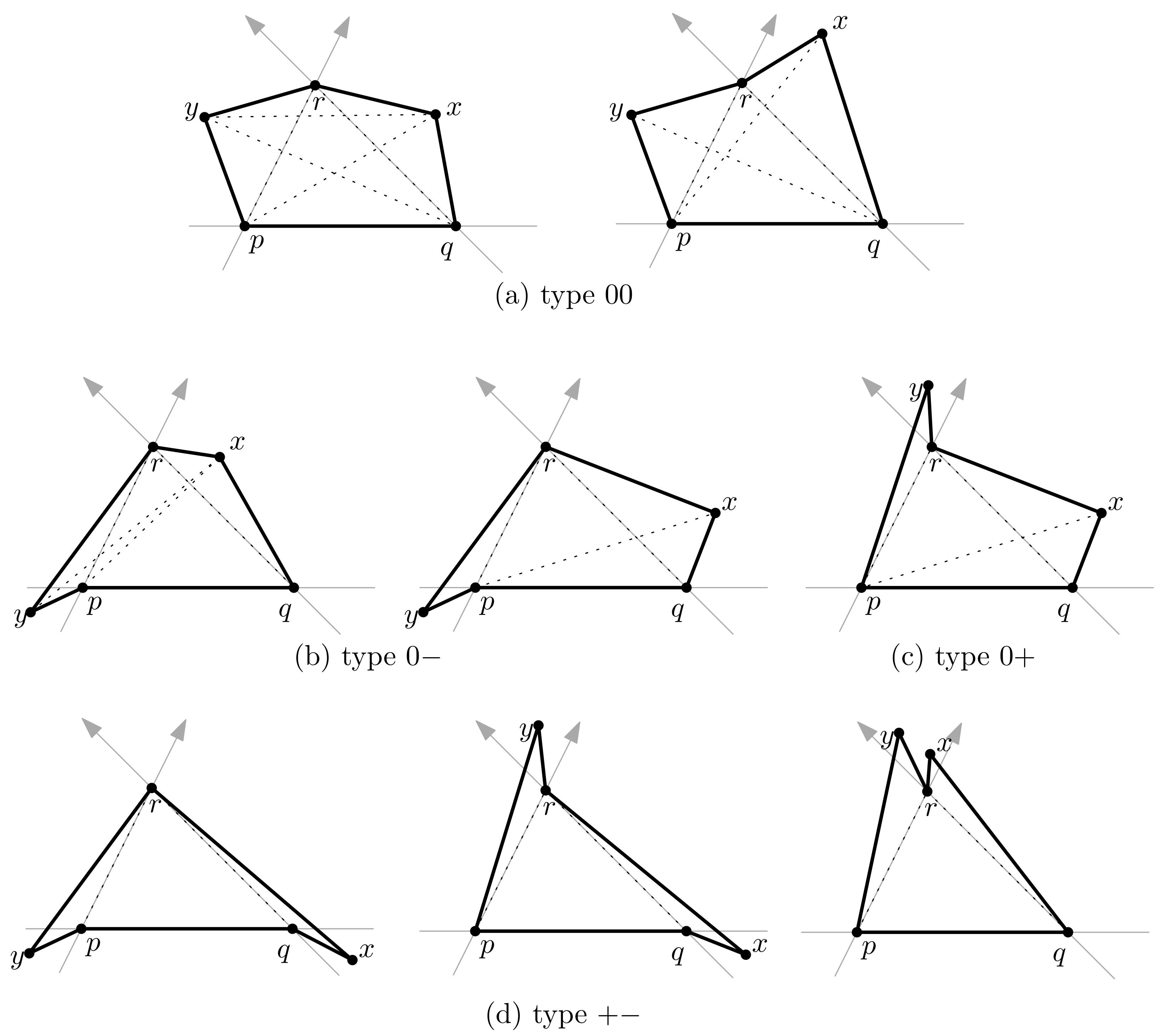Counting Non-Convex 5-Holes in a Planar Point Set
Abstract
1. Introduction
1.1. Our Contribution and Approach
1.2. Related Work
1.3. Organization of the Paper
2. Preliminaries
2.1. Empty Triangles and Their Structures
2.2. Empty Quadrilaterals
- (i)
- The 4-hole is convex if, and only if .
- (ii)
- The 4-hole is non-convex if, and only if or .
3. Middle Triangles of Empty Pentagons
- (a)
- type 00 if and ,
- (b)
- type if either and , or and ,
- (c)
- type if either and , or and , or
- (d)
- type , otherwise, if and .
- (a)
- If is of type 00, then either or .
- If , then and the other four middle triangles are all of type 00.
- If , then and the other two middle triangles are all of type .
- (b)
- If is of type , then either or .
- If , then and the other two middle triangles are of type and 00, respectively.
- If , then and the other middle triangle is of type .
- (c)
- If is of type , then and . The other middle triangle is of type .
- (d)
- If is of type , then and .
- (a)
- Suppose that is of type 00, so we have and . In this case, by Lemma 4, both 4-holes and are convex, so both and are diagonals of 5-hole . There are two cases: either is a diagonal or not.
- If is a diagonal, then there are diagonals of P, including and , and middle triangles of P: , , , and . Observe that all these five middle triangles are of type 00. See the left figure of Figure 4a.
- If is not a diagonal, then P has four diagonals, and three middle triangles: , , and . Observe that and are of type , while is of type 00. See the right figure of Figure 4a.
- (b)
- Suppose that is of type , so either and , or and . We assume the former case without loss of generality since the other case is symmetric. In this case, by Lemma 4, 4-hole is convex while 4-hole is non-convex, so is a diagonal of P but is not. There are two cases: either is a diagonal or not.
- If is a diagonal of P, then P has four diagonals and three middle triangles: , , and . Observe that and are of type , while is of type 00 type. See the left figure of Figure 4b.
- If is not a diagonal of P, then P has three diagonals and two middle triangles and . Observe that is of type , while is of type . See the right figure of Figure 4b.
- (c)
- Suppose that is of type , so either and , or and . We assume the former case without loss of generality, since the other case is symmetric. Similarly to the above case, the 4-hole is convex while the 4-hole is non-convex, so is a diagonal of P but is not. In this case, however, is always not a diagonal of P, since both x and y lie in a common side of the line through q and r. Thus, P has three diagonals and two middle triangles and . Observe that is of type , while is of type . See Figure 4c.
- (d)
- Suppose that is of type , so and . Then, none of the segments and can be a diagonal of P, as both 4-holes and are non-convex by Lemma 4. Additionally, observe that the segment cannot be a diagonal of P, either, by the following reason: if or , then corner r of P is a reflex vertex and, otherwise, if and , then both p and q are reflex vertices of P. See Figure 4d. Therefore, the pentagon P has exactly two diagonals and , and only one middle triangle of type .
- (i)
- If , then P is convex and has five middle triangles of type 00.
- (ii)
- If , then P has three middle triangles, two of which are of type and the third of which is of type 00.
- (iii)
- If , then P has two middle triangles, one of which is of type and the other of which is of type .
- (iv)
- If , then P has a unique middle triangle of type .
4. Counting Empty Pentagons
4.1. Attaching Two Empty Triangles to a Middle Triangle
- (a)
- Every 5-hole with five diagonals contributes 5 counts in , every 5-hole with four diagonals contributes 1 count in , and none of those with three or less diagonals contributes in .
- (b)
- Every 5-hole with four diagonals contributes 2 counts in , every 5-hole with three diagonals contributes 1 count in , and the others contribute nothing in .
- (c)
- Every 5-hole with three diagonals contributes 1 count in and the others contribute nothing in .
- (d)
- Every 5-hole with two diagonal contributes 1 count in .
4.2. Algorithm
| Algorithm 1 Count5Holes |
|
5. Concluding Remarks
Author Contributions
Funding
Institutional Review Board Statement
Informed Consent Statement
Data Availability Statement
Conflicts of Interest
References
- Dobkin, D.P.; Edelsbrunner, H.; Overmars, M.H. Searching for empty convex polygons. Algorithmica 1990, 5, 561–571. [Google Scholar] [CrossRef]
- Rote, G.; Wang, Z.; Woeginger, G.; Zhi, B. Counting k-subsets and convex k-gons in the plane. Inform. Proc. Lett. 1991, 38, 149–151. [Google Scholar] [CrossRef]
- Mitchell, J.; Rote, G.; Sundaram, G.; Woeginger, G. Counting convex polygons in planar point sets. Inform. Proc. Lett. 1995, 56, 45–49. [Google Scholar] [CrossRef]
- Rote, G.; Woeginger, G. Counting convex k-gons in planar point sets. Inform. Proc. Lett. 1992, 41, 191–194. [Google Scholar] [CrossRef]
- Bae, S.W. Faster counting empty convex polygons in a planar point set. Inform. Proc. Lett. 2022, 175, 106221. [Google Scholar] [CrossRef]
- Bárány, I.; Füredi, Z. Empty simplices in Euclidean space. Canad. Math. Bull. 1987, 30, 436–445. [Google Scholar] [CrossRef]
- Balko, M.; Scheucher, M.; Valtr, P. Holes and Islands in Random Point Sets. In Proceedings of the 36th International Symposium on Computational Geometry (SoCG 2020), Zurich, Switzerland, 23–26 June 2020; Cabello, S., Chen, D.Z., Eds.; LIPIcs. Schloss Dagstuhl–Leibniz-Zentrum für Informatik: Dagstuhl, Germany, 2020; Volume 164, pp. 14:1–14:16. [Google Scholar]
- Sung, Y.H.; Bae, S.W. Counting Convex and Non-convex 4-Holes in a Point Set. Trans. Fundam. Electron. Commun. Comput. Sci. 2021, E104.A, 1094–1100. [Google Scholar] [CrossRef]
- Aichholzer, O.; Fabila-Monroy, R.; González-Aguilar, H.; Hackl, T.; Heredia, M.A.; Huemer, C.; Urrutia, J.; Vogtenhuber, B. 4-Holes in point sets. Comput. Geom. Theory Appl. 2014, 47, 644–650. [Google Scholar] [CrossRef][Green Version]
- Fabila-Monroy, R.; Huemer, C.; Mitsche, D. Empty Non-convex and Convex Four-gons in Random Point Sets. Stud. Sci. Math. Hung. 2015, 52, 52–64. [Google Scholar] [CrossRef][Green Version]
- Bárány, I.; Valtr, P. Planar point sets with a small number of empty convex polygons. Stud. Sci. Math. Hung. 2005, 41, 243–269. [Google Scholar] [CrossRef]
- Aichholzer, O.; Fabila-Monroy, R.; González-Aguilar, H.; Hackl, T.; Heredia, M.A.; Huemer, C.; Urrutia, J.; Valtr, P.; Vogtenhuber, B. On k-gons and k-holes in point sets. Comput. Geom. Theory Appl. 2015, 48, 528–537. [Google Scholar] [CrossRef]
- Horton, J. Sets with no empty convex 7-gons. Canad. Math. Bull. 1983, 26, 482–484. [Google Scholar] [CrossRef]
- Aichholzer, O.; Balko, M.; Hackl, T.; Kynčl, J.; Parada, I.; Scheucher, M.; Valtr, P.; Vogtenhuber, B. A superlinear lower bound on the number of 5-holes. J. Comb. Theory Ser. A 2020, 173, 105236. [Google Scholar] [CrossRef]
- Erdős, P.; Szekeres, G. A combinatorial problem in geometry. Compos. Math. 1935, 2, 463–470. [Google Scholar]
- Erdős, P.; Szekeres, G. On some extremum problems in elementary geometry. Ann. Univ. Sci. Bp. Eötvös Sect. Math. 1961, 3–4, 53–62. [Google Scholar]
- Szekeres, G.; Peters, L. Computer solution to the 17-point Erdős–Szekeres problem. ANZIAM J. 2006, 48, 151–164. [Google Scholar] [CrossRef]
- Suk, A. On the Erdős–Szekeres Convex Polygon Problem. J. Am. Math. Soc. 2021, 30, 1047–1053. [Google Scholar] [CrossRef]
- Holmsen, A.F.; Mojarrad, H.N.; Pach, J.; Tardos, G. Two extensions of the Erdős–Szekeres Problem. J. Eur. Math. Soc. 2021, 22, 3981–3995. [Google Scholar] [CrossRef]
- Erdős, P. Some more problems on elementary geometry. Austral. Math. Soc. Gaz. 1978, 5, 52–54. [Google Scholar]
- Harborth, H. Kovexe Fünfecke in ebenen Punktmengen. Elem. Math. 1978, 33, 116–118. [Google Scholar]
- Nicolás, C.M. The Empty Hexagon Theorem. Discret. Comput. Geom. 2007, 38, 389–397. [Google Scholar] [CrossRef]
- Gerken, T. Empty Convex Hexagons in Planar Point Sets. Discret. Comput. Geom. 2008, 39, 239–272. [Google Scholar] [CrossRef]
- Morris, W.; Soltan, V. The Erdős–Szekeres Problem. In Open Problems in Mathematics; Nash, J.F., Jr., Rassias, M.T., Eds.; Springer International Publishing: Cham, Switzerland, 2016; pp. 351–375. [Google Scholar]
- Morris, W.; Soltan, V. The Erdős–Szekeres problem on points in convex position—A survey. Bull. Am. Math. Soc. 2000, 33, 437–458. [Google Scholar] [CrossRef]
- Valtr, P. On the minimum number of empty polygons in planar point sets. Stud. Sci. Math. Hung. 1995, 30, 155–163. [Google Scholar]
- Dumistrescu, A. Planar Sets with Few Empty Convex Polygons. Stud. Sci. Math. Hung. 2000, 36, 93–109. [Google Scholar]
- Pinchasi, R.; Radoičić, R.; Sharir, M. On empty convex polygons in a planar point set. J. Comb. Theory Ser. A 2006, 113, 385–419. [Google Scholar] [CrossRef]
- Fredman, M.L.; Komlós, J. On the Size of Separating Systems and Families of Perfect Hash Functions. SIAM J. Algebr. Discret. Methods 1984, 5, 61–68. [Google Scholar] [CrossRef]
- Belazzougui, D.; Botelho, F.C.; Dietzfelbinger, M. Hash, Displace, and Compress. In European Symposium on Algorithms; Lecture Notes in Computer Science; Fiat, A., Sanders, P., Eds.; Springer: Berlin/Heidelberg, Germany, 2009; Volume 5757, pp. 682–693. [Google Scholar]






| Minimum | Maximum | Expected | |||||
|---|---|---|---|---|---|---|---|
| , | [11] | [easy] | [6] | ||||
| , | [11] | [easy] | [10] | ||||
| 0 | [easy] | [9] | [10] | ||||
| , | [9,10,12] | [9] | [10] | ||||
| [11,13,14] | [easy] | [7] | |||||
| 0 | [easy] | [12] | [12] | ||||
| , | [12] | [12] | [12] | ||||
Publisher’s Note: MDPI stays neutral with regard to jurisdictional claims in published maps and institutional affiliations. |
© 2022 by the authors. Licensee MDPI, Basel, Switzerland. This article is an open access article distributed under the terms and conditions of the Creative Commons Attribution (CC BY) license (https://creativecommons.org/licenses/by/4.0/).
Share and Cite
Sung, Y.-H.; Bae, S.W. Counting Non-Convex 5-Holes in a Planar Point Set. Symmetry 2022, 14, 78. https://doi.org/10.3390/sym14010078
Sung Y-H, Bae SW. Counting Non-Convex 5-Holes in a Planar Point Set. Symmetry. 2022; 14(1):78. https://doi.org/10.3390/sym14010078
Chicago/Turabian StyleSung, Young-Hun, and Sang Won Bae. 2022. "Counting Non-Convex 5-Holes in a Planar Point Set" Symmetry 14, no. 1: 78. https://doi.org/10.3390/sym14010078
APA StyleSung, Y.-H., & Bae, S. W. (2022). Counting Non-Convex 5-Holes in a Planar Point Set. Symmetry, 14(1), 78. https://doi.org/10.3390/sym14010078






